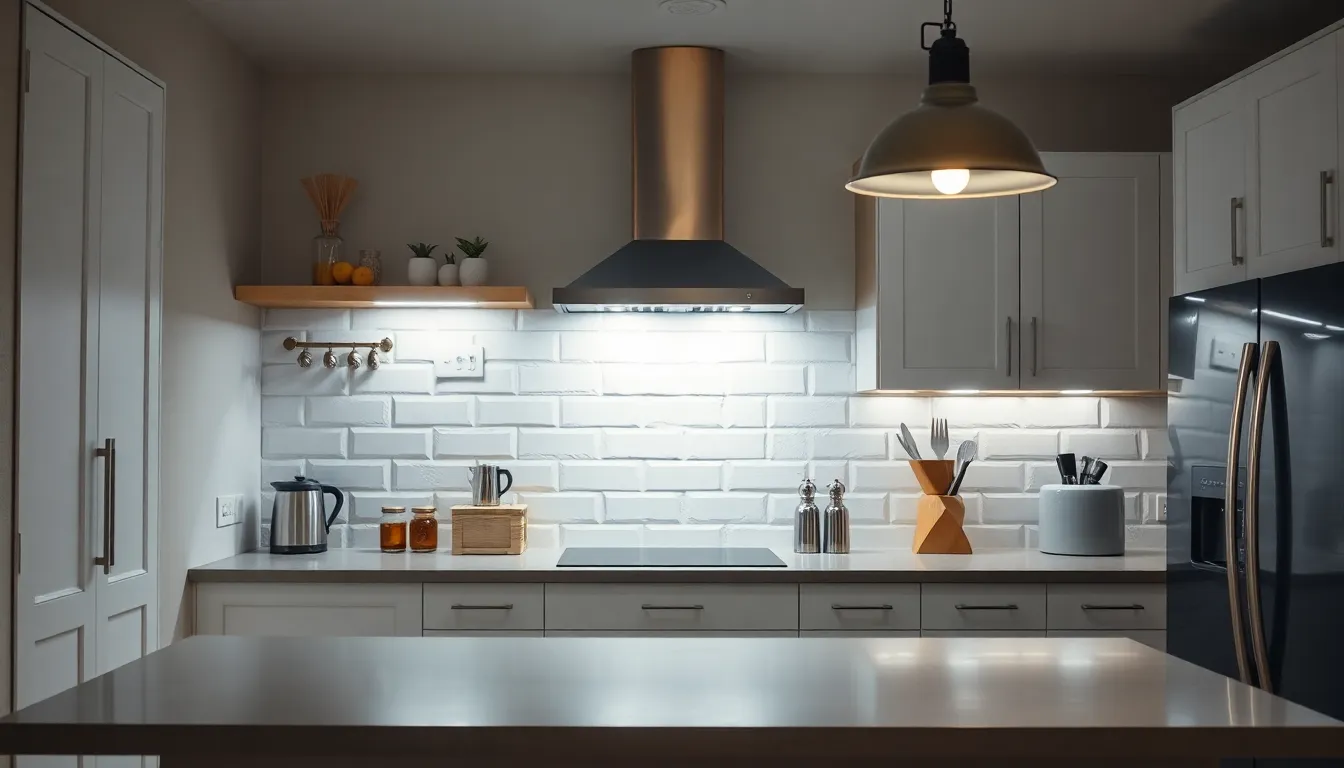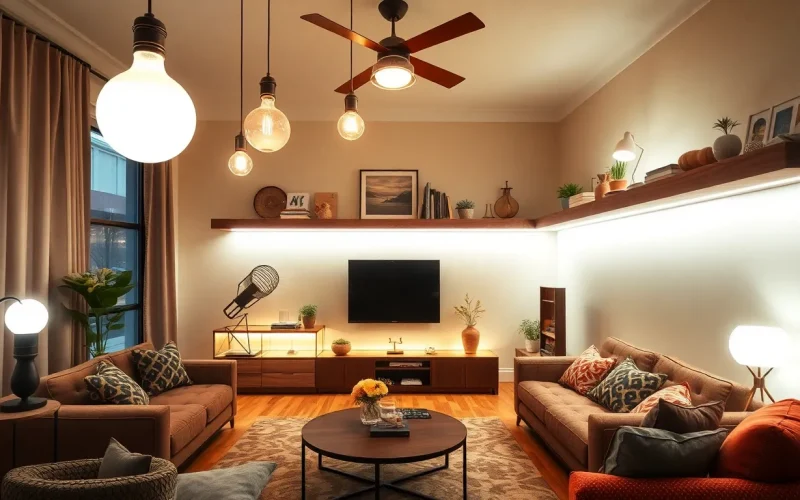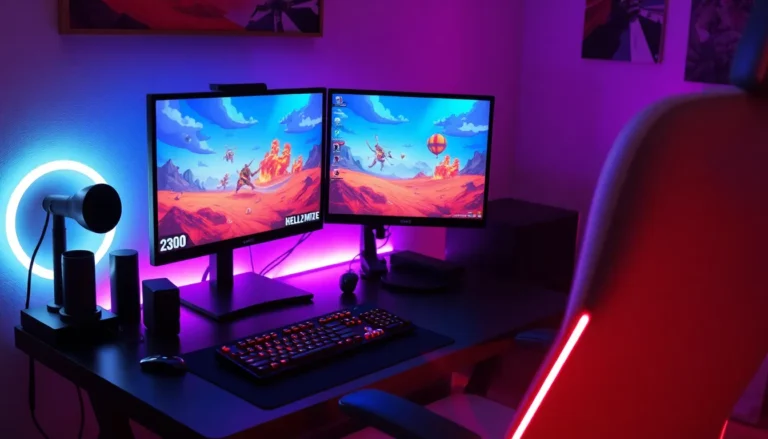Table of Contents
ToggleWhen it comes to lighting up a space, LED options are like the superheroes of the bulb world. They’re energy-efficient, long-lasting, and can even make your home look like a million bucks without costing you an arm and a leg. Who knew saving the planet could feel so good?
Overview Of LED Lighting Options
LED lighting offers various options tailored to different needs and preferences. Bulbs come in multiple shapes like A19, BR30, and PAR38, making them suitable for standard fixtures and specialized applications. Color temperatures range from warm white (2700K) to cool daylight (6500K), allowing users to create the desired ambiance in any space.
Dimmer compatibility enhances functionality, enabling users to adjust brightness levels easily. Some LED lights are designed specifically for dimming, while others may require compatible dimmer switches for optimal performance. Smart LED options provide additional convenience through features like remote controls and scheduling functions.
In addition to traditional bulbs, LED strips and panels cater to diverse lighting applications. Flexible LED strips can be cut to fit specific spaces, making them ideal for accent lighting or under-cabinet illumination. Panel lights offer sleek designs suitable for commercial and residential settings.
Energy consumption varies among LED options, with standard bulbs typically using 8-12 watts. LEDs can last up to 25,000 hours, significantly reducing the frequency of replacements. This longevity contributes to lower waste and energy costs, reinforcing their environmental benefits.
Selecting the right LED lighting depends on the intended use, placement, and personal preference. Evaluating brightness, color quality, and energy efficiency ensures users achieve the best results in their spaces.
Benefits Of LED Lighting

LED lighting offers numerous advantages that make it a popular choice for both residential and commercial use. These benefits include energy efficiency, longevity, and cost-effectiveness.
Energy Efficiency
Energy efficiency stands out as one of the most significant benefits of LED lighting. Compared to traditional incandescent bulbs, LEDs consume up to 80% less energy. This reduction in energy usage leads to lower electricity bills. LED lights also produce more lumens per watt, providing brighter light without increasing energy consumption. Many homes experience substantial savings on energy costs, making the switch to LED lighting a smart financial decision.
Longevity
Longevity is another key advantage of LED lighting. These bulbs typically last between 15,000 to 25,000 hours, far surpassing the lifespan of incandescent bulbs, which often last only about 1,000 hours. This extended lifespan significantly reduces the frequency of replacements. With fewer bulbs discarded, LED lighting also contributes to less waste, reinforcing sustainability efforts. Overall, choosing LED lighting means reduced hassle and long-term savings in replacement costs.
Types Of LED Lighting Options
A variety of LED lighting options exist to meet different needs and preferences. Below are two primary categories: residential and commercial.
Residential LED Bulbs
Residential LED bulbs include A19, BR30, and PAR38 shapes. These bulbs provide energy efficiency, consuming 8-12 watts while offering a warm white to cool daylight spectrum ranging from 2700K to 6500K. Many residential options are dimmable, allowing for adjustable brightness according to mood or activity. Smart LED bulbs provide remote control and scheduling features, enhancing convenience. With a lifespan of up to 25,000 hours, these bulbs significantly reduce the frequency of replacements and electricity costs, making them highly suitable for home use.
Commercial LED Solutions
Commercial LED solutions encompass a range of products such as panel lights, floodlights, and high bay fixtures. Designed for larger spaces, these options deliver high lumen output while maintaining energy efficiency. Typical energy usage falls between 8-12 watts, providing savings on electricity bills. Longevity is also a critical factor; many commercial LEDs last 15,000 to 25,000 hours, minimizing maintenance needs. Flexible LED strips fit various installations and applications, offering adaptability in commercial environments. Selecting the right commercial LED solution enhances productivity while contributing to sustainability goals.
Choosing The Right LED Lighting
Selecting appropriate LED lighting requires understanding specific characteristics. Lumens measure brightness, while watts indicate energy consumption. Focusing on lumens ensures adequate brightness for various spaces. For example, a standard 60-watt incandescent bulb produces around 800 lumens. An LED bulb providing similar brightness typically consumes only 8-12 watts.
Color temperature affects ambiance and functionality. Ranging from warm white (2700K) to cool daylight (6500K), warmer tones create inviting environments. In contrast, cooler tones enhance attention in workspaces. Opting for 3000K provides a cozy feel, suitable for living areas. Consider spaces where the lighting will be used and choose color temperatures that align with desired moods.
Popular Brands And Products
Several brands dominate the LED lighting market, each offering innovative products catering to various preferences. Philips leads the industry with its extensive range, including the popular Hue smart bulbs, which allow users to customize colors and set schedules via a smartphone app.
Cree has established a reputation for energy-efficient bulbs designed for performance and sustainability. Their 60-watt equivalent LED bulbs emit around 800 lumens while using just 9 watts of power, making them a great choice for energy-conscious consumers.
GE Lighting also provides a range of LED options, including their Reveal line that enhances colors and details. These bulbs maintain high lumen output, supporting superior visibility in various settings.
Sylvania offers versatile solutions with their Smart LED products that feature adjustable brightness and color temperatures, accommodating different environments. Their product line includes both traditional and innovative designs suitable for residential and commercial applications.
LIFX stands out with their Wi-Fi-enabled bulbs, which can display millions of colors and integrate with home automation systems. These bulbs facilitate unique lighting setups, making them ideal for creative users.
Lastly, Osram specializes in professional solutions, providing high-quality LED fixtures for commercial settings. Their products focus on achieving high lumen output while minimizing energy consumption, aligning with sustainability goals.
Each brand presents unique advantages, making it crucial for consumers to consider their specific needs when selecting LED products. Factors like energy consumption, brightness levels, and smart features determine the most suitable options for individual or business use.
Embracing LED lighting options is a smart choice for anyone looking to enhance their space while promoting sustainability. With a variety of styles and features available there’s an LED solution for every need. From energy-efficient bulbs to smart technology and versatile designs, LED lighting not only reduces electricity costs but also minimizes waste.
By understanding the differences in lumens and color temperatures, individuals can create the perfect ambiance in their homes or workplaces. As the market continues to expand with innovative products from leading brands, selecting the right LED lighting has never been easier. Making informed choices today will lead to brighter and more sustainable tomorrows.





